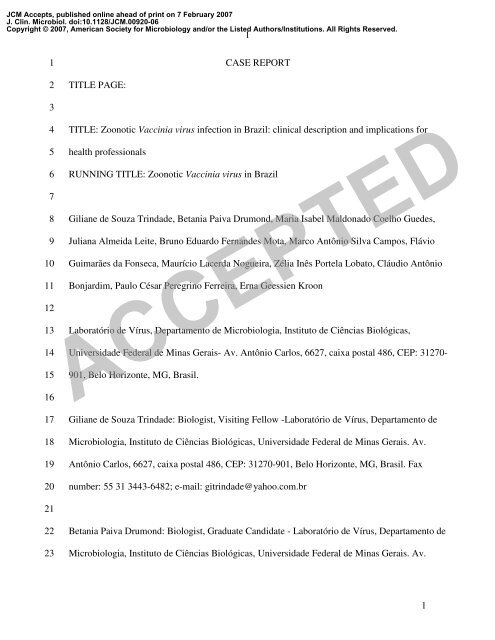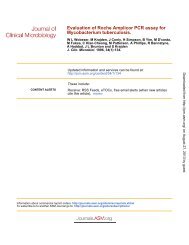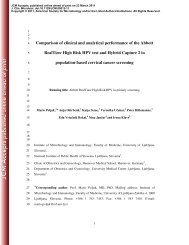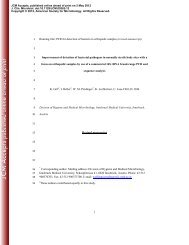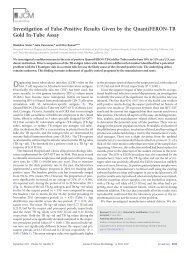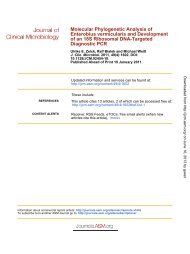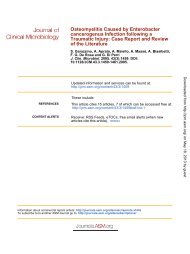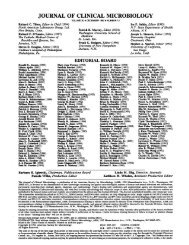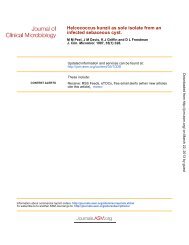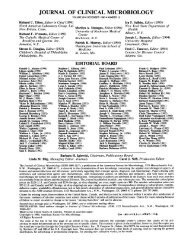case report 1 title page - Journal of Clinical Microbiology - American ...
case report 1 title page - Journal of Clinical Microbiology - American ...
case report 1 title page - Journal of Clinical Microbiology - American ...
Create successful ePaper yourself
Turn your PDF publications into a flip-book with our unique Google optimized e-Paper software.
JCM Accepts, published online ahead <strong>of</strong> print on 7 February 2007<br />
J. Clin. Microbiol. doi:10.1128/JCM.00920-06<br />
Copyright © 2007, <strong>American</strong> Society for <strong>Microbiology</strong> and/or the Listed Authors/Institutions. All Rights Reserved.<br />
1<br />
2<br />
3<br />
4<br />
5<br />
6<br />
7<br />
8<br />
9<br />
10<br />
11<br />
12<br />
13<br />
14<br />
15<br />
16<br />
17<br />
18<br />
19<br />
20<br />
21<br />
22<br />
23<br />
TITLE PAGE:<br />
1<br />
CASE REPORT<br />
TITLE: Zoonotic Vaccinia virus infection in Brazil: clinical description and implications for<br />
health pr<strong>of</strong>essionals<br />
RUNNING TITLE: Zoonotic Vaccinia virus in Brazil<br />
Giliane de Souza Trindade, Betania Paiva Drumond, Maria Isabel Maldonado Coelho Guedes,<br />
Juliana Almeida Leite, Bruno Eduardo Fernandes Mota, Marco Antônio Silva Campos, Flávio<br />
Guimarães da Fonseca, Maurício Lacerda Nogueira, Zélia Inês Portela Lobato, Cláudio Antônio<br />
Bonjardim, Paulo César Peregrino Ferreira, Erna Geessien Kroon<br />
Laboratório de Vírus, Departamento de Microbiologia, Instituto de Ciências Biológicas,<br />
ACCEPTED<br />
Universidade Federal de Minas Gerais- Av. Antônio Carlos, 6627, caixa postal 486, CEP: 31270-<br />
901, Belo Horizonte, MG, Brasil.<br />
Giliane de Souza Trindade: Biologist, Visiting Fellow -Laboratório de Vírus, Departamento de<br />
Microbiologia, Instituto de Ciências Biológicas, Universidade Federal de Minas Gerais. Av.<br />
Antônio Carlos, 6627, caixa postal 486, CEP: 31270-901, Belo Horizonte, MG, Brasil. Fax<br />
number: 55 31 3443-6482; e-mail: gitrindade@yahoo.com.br<br />
Betania Paiva Drumond: Biologist, Graduate Candidate - Laboratório de Vírus, Departamento de<br />
Microbiologia, Instituto de Ciências Biológicas, Universidade Federal de Minas Gerais. Av.<br />
1
1<br />
2<br />
3<br />
4<br />
5<br />
6<br />
7<br />
8<br />
9<br />
10<br />
11<br />
12<br />
13<br />
14<br />
15<br />
16<br />
17<br />
18<br />
19<br />
20<br />
21<br />
22<br />
23<br />
2<br />
Antônio Carlos, 6627, caixa postal 486, CEP: 31270-901, Belo Horizonte, MG, Brasil. Fax<br />
number: 55 31 3443-6482; e-mail: betaniadrumond@uol.com.br<br />
Maria Isabel Maldonado Coelho Guedes: Veterinarian, Post-Doctoral Fellow - Laboratório de<br />
Vírus, Departamento de Microbiologia, Instituto de Ciências Biológicas, Universidade Federal<br />
de Minas Gerais. Av. Antônio Carlos, 6627, caixa postal 486, CEP: 31270-901, Belo Horizonte,<br />
MG, Brasil. Fax number: 55 31 3443-6482; e-mail: isabelguedes@icb.ufmg.br<br />
Juliana Almeida Leite: Biologist, Graduate Candidate - Laboratório de Vírus, Departamento de<br />
Microbiologia, Instituto de Ciências Biológicas, Universidade Federal de Minas Gerais. Av.<br />
Antônio Carlos, 6627, caixa postal 486, CEP: 31270-901, Belo Horizonte, MG, Brasil. Fax<br />
number: 55 31 3443-6482; e-mail: ju@icb.ufmg.br<br />
ACCEPTED<br />
Bruno Eduardo Fernandes Mota: Biologist, Graduate Candidate - Laboratório de Vírus,<br />
Departamento de Microbiologia, Instituto de Ciências Biológicas, Universidade Federal de<br />
Minas Gerais. Av. Antônio Carlos, 6627, caixa postal 486, CEP: 31270-901, Belo Horizonte,<br />
MG, Brasil. Fax number: 55 31 3443-6482; e-mail: brun<strong>of</strong>mota@gmail.com<br />
Marco Antônio Silva Campos: Pharmacist, Senior Scientist - Laboratório de Imunopatologia,<br />
Centro de Pesquisas René Rachou - FIOCRUZ , Av. Augusto de Lima, 1715 Barro Preto CEP:<br />
30190-002, Belo Horizonte ,MG, Brasil. Fax number: 55 31 3295-3115, e-mail:<br />
marcoasc@cpqrr.fiocruz.br<br />
2
1<br />
2<br />
3<br />
4<br />
5<br />
6<br />
7<br />
8<br />
9<br />
10<br />
11<br />
12<br />
13<br />
14<br />
15<br />
16<br />
17<br />
18<br />
19<br />
20<br />
21<br />
22<br />
23<br />
24<br />
3<br />
Flávio Guimarães da Fonseca: Biologist, Visiting Scientist - Laboratório de Imunologia Celular e<br />
Molecular, Centro de Pesquisas René Rachou - FIOCRUZ , Av. Augusto de Lima, 1715 Barro<br />
Preto CEP: 30190-002, Belo Horizonte ,MG, Brasil. Fax number: 55 31 3295-3115, e-mail:<br />
fdafonseca@cpqrr.fiocruz.br<br />
Maurício Lacerda Nogueira: Medical Doctor, Assistant Pr<strong>of</strong>essor - Laboratório de Pesquisas em<br />
Virologia, Departamento de Doenças Infecciosas e Parasitárias Faculdade de Medicina de São<br />
José do Rio Preto, Av. Brigadeiro Faria Lima, 5416 CEP:15090-000, São Jose do Rio Preto, SP,<br />
Brasil FAX number: (17) 2105872, e-mail: mnogueira@famerp.br<br />
Zélia Inês Portela Lobato: Veterinarian, Associated Pr<strong>of</strong>essor - Departamento de Medicina<br />
Preventiva, Escola de Veterinária, Universidade Federal de Minas Gerais. Av. Antônio Carlos,<br />
6627, caixa postal , CEP: 31270-901, Belo Horizonte, MG, Brasil. Fax number: 55 31 3443-<br />
ACCEPTED<br />
6482; e-mail: ziplobat@vet.ufmg.br<br />
Cláudio Antônio Bonjardim: Pharmacist, Associated Pr<strong>of</strong>essor - Laboratório de Vírus,<br />
Departamento de Microbiologia, Instituto de Ciências Biológicas, Universidade Federal de<br />
Minas Gerais. Av. Antônio Carlos, 6627, caixa postal 486, CEP: 31270-901, Belo Horizonte,<br />
MG, Brasil. Fax number: 55 31 3443-6482; e-mail: claubonj@icb.ufmg.br<br />
Paulo César Peregrino Ferreira*: Pharmacist, Pr<strong>of</strong>essor - Laboratório de Vírus, Departamento de<br />
Microbiologia, Instituto de Ciências Biológicas, Universidade Federal de Minas Gerais. Av.<br />
Antônio Carlos, 6627, caixa postal 486, CEP: 31270-901, Belo Horizonte, MG, Brasil. Fax<br />
number: 55 31 3443-6482; e-mail: paulocpf@icb.ufmg.br<br />
3
1<br />
2<br />
3<br />
4<br />
5<br />
6<br />
7<br />
8<br />
9<br />
10<br />
11<br />
12<br />
13<br />
14<br />
15<br />
16<br />
17<br />
18<br />
19<br />
20<br />
21<br />
22<br />
23<br />
24<br />
4<br />
Erna Geessien Kroon: Pharmacist, Associated Pr<strong>of</strong>essor - Laboratório de Vírus, Departamento de<br />
Microbiologia, Instituto de Ciências Biológicas, Universidade Federal de Minas Gerais. Av.<br />
Antônio Carlos, 6627, caixa postal 486, CEP: 31270-901, Belo Horizonte, MG, Brasil. Fax<br />
number: 55 31 3443-6482; e-mail: kroone@icb.ufmg.br<br />
FOOTNOTE PAGE:<br />
(1)*Corresponding author: Paulo César Peregrino Ferreira: Pharmacist, Pr<strong>of</strong>essor - Laboratório<br />
de Vírus, Departamento de Microbiologia, Instituto de Ciências Biológicas, Universidade<br />
Federal de Minas Gerais. Av. Antônio Carlos, 6627, caixa postal 486, CEP: 31270-901, Belo<br />
Horizonte, MG, Brasil. Fax number: 55 31 3443-6482; e-mail: masc.egk@terra.com.br<br />
(2) The nucleotide sequences from Muriaé virus were deposited at GenBank under accession<br />
numbers: ha: DQ247770, tk: DQ247771 and vgf: DQ247772.<br />
ACCEPTED<br />
(3) Upon participation in this study a signed informed consent from all patients investigated<br />
during this outbreak were obtained before biological samples were collected and the<br />
questionnaire done. The documents presented the patients the objectives <strong>of</strong> study as well as<br />
possible risks and benefits involved on their participation.<br />
(4) Juliana Almeida Leite Present address: Juliana Almeida Leite: Biologist, Researcher -<br />
Brazilian Agricultural Research Corporation / Embrapa Dairy Cattle, Rua Eugênio do<br />
Nascimento, 610, Dom Bosco, CEP: 36.038-330, Juiz de Fora, MG, Brasil. Fax number: 55 32<br />
3249-4700; e-mail: juliana@cnpgl.embrapa.br<br />
4
1<br />
2<br />
3<br />
4<br />
5<br />
6<br />
7<br />
8<br />
9<br />
10<br />
11<br />
12<br />
13<br />
14<br />
15<br />
16<br />
17<br />
18<br />
19<br />
20<br />
21<br />
22<br />
23<br />
24<br />
ABSTRACT<br />
5<br />
Bovine vaccinia outbreaks have been occurring in different regions <strong>of</strong> Brazil. Here we <strong>report</strong> the<br />
time-course <strong>of</strong> natural human infection by Vaccinia virus and important clinical and<br />
epidemiological aspects <strong>of</strong> this zoonotic infection. Vaccinia virus infection diagnosis was based<br />
on clinical, serological and molecular procedures.<br />
CASE REPORT<br />
Here, we had examined clinical and epidemiological aspects <strong>of</strong> one <strong>case</strong> <strong>of</strong> zoonotic<br />
human infection during a bovine vaccinia outbreak and characterized the causative agent as a<br />
Vaccinia virus (VACV) strain.<br />
In August 2000, vesicular and exanthemous disease outbreaks affecting dairy cattle<br />
and milkers were observed on several farms in Minas Gerais, the most important milk producing<br />
State in Brazil. At one farm, a smallpox unvaccinated 19-year-old male dairy farm milker<br />
ACCEPTED<br />
(Patient one) became sick and developed many lesions after being in contact with cows<br />
presenting lesions on their udders. These lesions started as itchy points on the hands, followed by<br />
the appearance <strong>of</strong> local edema, and after three days, the patient <strong>report</strong>ed fever, headache,<br />
exhaustion and vesicles on his hands. After a period <strong>of</strong> three or four days, these vesicles evolved<br />
to ulcerated lesions mainly characterized as umbilicated pustules surrounded by inflammatory<br />
tissue and painful ulcers on the hands and fingers (Fig 1A-B). At this time, the milker <strong>report</strong>ed<br />
the presence <strong>of</strong> peripheral erythema and lymphadenitis, with enlarged lymph nodes and a<br />
secondary bacterial infection on the lesions. Despite all the clinical symptoms <strong>of</strong> systemically<br />
illness the patient did not cease working. Only on day 10 was the patient admitted at the local<br />
public hospital and received treatment based on fever and pain relievers and topical antibiotics<br />
due to the secondary bacterial infection. A serum sample and a biopsy from the necrotic black<br />
5
1<br />
2<br />
3<br />
4<br />
5<br />
6<br />
7<br />
8<br />
9<br />
10<br />
11<br />
12<br />
13<br />
14<br />
15<br />
16<br />
17<br />
18<br />
19<br />
20<br />
21<br />
22<br />
23<br />
24<br />
6<br />
scar were collected and sent to the laboratory in order to establish the etiology <strong>of</strong> the lesions.<br />
Antibodies against Orhtopoxvirus were detected in patient’s serum sample by a serum<br />
neutralization (SN) assay. The biopsy sample was then ground, homogenized and inoculated<br />
onto chorioallantoic membrane (CAM) <strong>of</strong> embryonated chicken eggs, where, after 72 hours,<br />
white and opaque classical pock formations were observed, suggesting a Vaccinia virus (VACV)<br />
infection (3,6,9). The “pocks” were used for virus propagation in Vero cells, where a typical<br />
cytophatic effect was also observed. The isolated virus showed typical Poxvirus brick-shaped<br />
particles when visualized by Atomic Force Microscopy (AFM) (5) (Fig. 1C-D).<br />
Additionally, for the molecular characterization <strong>of</strong> the isolated poxvirus, the<br />
thymidine kinase (tk), vaccinia growth factor (vgf) and hemagglutinin gene (ha), genes<br />
were amplified, the amplicons were cloned into the pGEM-T vector (pGEM-T Easy Vector<br />
Systems, Promega Corp., Madison, WI) and three clones for each gene were sequenced (3,<br />
9, 6,9). Tk and vgf are conserved genes in the Orthopoxvirus genus and have previously<br />
ACCEPTED<br />
been used as taxonomic tools to study ungrouped poxvirus (3,9). When the tk and vgf<br />
nucleotide sequences from the isolated virus were compared to Orthopoxvirus sequences,<br />
higher similarity values were found among the Vaccinia virus sequences (above 99% and<br />
97%, respectively), confirming that the isolated virus was, indeed, a Vaccinia virus strain.<br />
On the other hand, ha is a less conserved gene among Vaccinia virus strains that has been<br />
used as molecular tool to differentiate Brazilian VACV samples. (1,3,6,9). The ha<br />
nucleotide sequence presented the same signature deletion comprising 18 nt as was also<br />
observed for other Brazilian VACV strains isolated from cattle during vaccinia outbreaks in<br />
the southeast Brazil: Passatempo (PSTV) (3), Araçatuba virus (ARAV) (9), Guarani P2<br />
(GP2V) (10) and Cantagalo virus (CTGV) (1). Despite these similarities, the ha sequence<br />
<strong>of</strong> the isolated virus also presented unique differences that allow for its differentiation from<br />
6
1<br />
2<br />
3<br />
4<br />
5<br />
6<br />
7<br />
8<br />
9<br />
10<br />
11<br />
12<br />
13<br />
14<br />
15<br />
16<br />
17<br />
18<br />
19<br />
20<br />
21<br />
22<br />
23<br />
24<br />
the other Brazilian VACV strains. Comparing the deduced amino acid sequence from the<br />
isolated virus with those belonging to PSTV, ARAV, GP2V, CTGV and VACV-Lister,<br />
identity values ranging from 94% to 98% were obtained. Orthopoxvirus ha nucleotide<br />
sequences, were aligned by Clustal W (8) and used to construct phylogenetic trees by the<br />
Neighbor joining method using the Tamura Nei model <strong>of</strong> nucleotide substitution (7)<br />
implemented in the s<strong>of</strong>tware MEGA3 (2). The newly isolated virus was clustered with<br />
VACV strains (Fig. 2A) and presented a closer relationship with the Brazilian VACV<br />
strains PSTV (3), ARAV (9), GP2V (10) and CTGV (1) (Fig. 2A and 2B). Molecular<br />
characterization and phylogenetic analysis suggest that Muriae virus (MURV) might<br />
7<br />
represent yet another Brazilian VACV strain obtained from bovine vaccinia outbreaks and<br />
the first isolated from a human infection accompanied by a time-course.<br />
In addition, is important to mention that at least 3 other patients, all male milkers from the<br />
same rural area as the patient, presented the same type <strong>of</strong> painful lesions with fever and<br />
ACCEPTED<br />
lymphadenitis, characterizing a systemic illness. Consistent with other outbreaks investigated in<br />
Brazil, most <strong>case</strong>s in this outbreak share the same epidemiological aspects (1, 3, 4, 6, and 9). All<br />
four patients were male and milkers or farmers that had direct contact with dairy herds,<br />
characterizing this disease as an occupational zoonosis. In addition, in almost all <strong>report</strong>ed <strong>case</strong>s,<br />
infected milkers were unable to work, causing economic losses to their families. Besides being in<br />
contact with affected cows, the milkers also related contact with other domestic animals, such as<br />
pigs and dogs that were apparently not affected.<br />
It is clear that this <strong>case</strong> <strong>report</strong> is part <strong>of</strong> an ongoing epidemic zoonosis, caused by<br />
different strains <strong>of</strong> VACV that has continually affected rural areas <strong>of</strong> Southeast Brazil<br />
(1,3,6,9,10). The emergence <strong>of</strong> this zoonosis thirty years after the end <strong>of</strong> smallpox vaccination<br />
certainly points to a decline in cohort immunity against orthopoxviruses resulting in an important<br />
7
1<br />
2<br />
3<br />
4<br />
5<br />
6<br />
7<br />
8<br />
9<br />
10<br />
11<br />
12<br />
13<br />
14<br />
15<br />
16<br />
17<br />
18<br />
19<br />
20<br />
21<br />
22<br />
public health problem. Also <strong>of</strong> great importance is the fact that clinicians and other health<br />
8<br />
pr<strong>of</strong>essionals had problems with diagnosing and managing these infections. Many <strong>of</strong> the patients<br />
presenting lesions caused by poxviruses were treated with topical corticoids and <strong>of</strong>ten had the<br />
lesions excised. Both factors favor the spread <strong>of</strong> the virus to different parts <strong>of</strong> the body and the<br />
delay in the healing process. Another serious risk is represented by the nosocomial spread <strong>of</strong> the<br />
virus during patient’s hospitalization, which emphasizes the necessity necessity <strong>of</strong> patient<br />
isolation and/or strengthening <strong>of</strong> disinfection measures.<br />
Zoonotic Orthopoxvirus infections are increasingly being recognized in unusual<br />
geographical areas, such as Monkeypox virus in the USA and VACV in Brazil; therefore, some<br />
aspects <strong>of</strong> the outbreak described here could provide insights toward understanding the<br />
epidemiological and clinical features <strong>of</strong> zoonotic poxvirus diseases (3, 4, 9). In summary, the<br />
objective <strong>of</strong> this work was to describe the clinical aspects <strong>of</strong> this emergent disease in humans in<br />
order to alert and help physicians and other health authorities as to how to recognize the lesions<br />
ACCEPTED<br />
and the procedures that should be avoided by clinicians and health staff. Also, our findings<br />
confirm the circulation <strong>of</strong> a novel Vaccinia virus strain, raising questions about the establishment<br />
<strong>of</strong> these viruses in Brazil. In this context, more studies should be conducted which focus on this<br />
zoonosis and the viruses that cause it in order to characterize the epidemiology <strong>of</strong> the disease,<br />
such as the identification <strong>of</strong> potential reservoirs <strong>of</strong> the viruses and the chain or transmission and<br />
also to have a better understanding <strong>of</strong> the immune response after a natural infection with an<br />
Orthopoxvirus .<br />
REFERENCES<br />
8
1<br />
2<br />
3<br />
4<br />
5<br />
6<br />
7<br />
8<br />
9<br />
10<br />
11<br />
12<br />
13<br />
14<br />
15<br />
16<br />
17<br />
18<br />
19<br />
20<br />
21<br />
22<br />
23<br />
24<br />
9<br />
1. Damaso, C.R.A., Esposito, J.J., Condit, R., Moussatché, N. 2000. An emergent poxvirus from<br />
humans and cattle in Rio de Janeiro state: Cantagalo virus may derive from Brazilian smallpox<br />
vaccine. Virology 277: 439-449.<br />
2. Kumar, S., Tamura, K., Nei, M. 2004. MEGA3: Integrated s<strong>of</strong>tware for Molecular Evolutionary<br />
Genetics Analysis and sequence alignment. Brief Bioinform 5: 150-163.<br />
3. Leite, J,A., Drumond, B.P., Trindade, G.S., Lobato, Z.I.P., da Fonseca, F.G., dos Santos, J.R.,<br />
Madureira, M.C., Guedes, M.I.M.C., Ferreira, J.M.S., Bonjardim, C.A., Ferreira, P.C., Kroon,<br />
E.G. 2005. Passatempo virus: a novel Vaccinia virus isolated during a zoonotic outbreak in<br />
Brazil. Emerg. Infect. Dis. 11: 1935-1938.<br />
4. Lewis-Jones, S. 2004. Zoonotic poxvirus infections in humans. Curr Opin Infect Dis 17: 81-89.<br />
5. Malkin, A.J., McPherson, A., Gershon, P.D. 2003. Structure <strong>of</strong> intracellular mature vaccinia<br />
virus vizsualized by in situ atomic force microscopy. J Virol 77: 6332-6340.<br />
6. Nagasse-Sugahara, T.K., Kisielius, J.J., Ueda-Ito, M., Curti, S.P., Figueiredo, C.A., Cruz, A.S.,<br />
ACCEPTED<br />
Silva, M.M., Ramos, C.H., Silva, M.C., Sakurai, T., Salles-Gomes, L.F. 2004. Human vaccinia-<br />
like virus outbreaks in Sao Paulo and Goias States, Brazil: virus detection, isolation and<br />
identification. Rev Inst Med Trop Sao Paulo 46: 315-322.<br />
7. Tamura, K., Nei, M. 1993. Estimation <strong>of</strong> the number <strong>of</strong> nucleotide substitutions in the control<br />
region <strong>of</strong> mitochondrial DNA in humans and chimpanzees. Mol Biol Evol 10: 512-526.<br />
8. Thompson, J.D., Higgins, D.G., Gibson. T.J. 1994. CLUSTAL W: improving the sensitivity <strong>of</strong><br />
progressive multiple sequence alignment through sequence weighting, position-specific gap<br />
penalties and weight matrix choice. Nucleic Acids Res 22: 4673-4680.<br />
9. Trindade, G.S., Fonseca, F.G., Marques, J.T., Nogueira, M.L., Mendes, L.C., Borges, A.S.,<br />
Pituco, E.M., Bonjardim, C.A., Ferreira, P.C., Kroon, E.G. 2003. Araçatuba virus: a vaccinia-<br />
like virus associated with cattle and human infection. Emerg Infect Dis 9: 155-160.<br />
9
1<br />
2<br />
3<br />
4<br />
5<br />
6<br />
7<br />
8<br />
9<br />
10<br />
11<br />
12<br />
13<br />
14<br />
15<br />
16<br />
17<br />
18<br />
19<br />
20<br />
21<br />
22<br />
23<br />
24<br />
10<br />
10. Trindade G.S., Lobato Z.I.P., Drumond B.P., Leite J.A., Trigueiro R.C., Guedes M.I.M.C., et<br />
al. 2006. Isolation <strong>of</strong> two Vaccinia virus strains from a single bovine vaccinia outbreak in rural<br />
area from Brazil: implications on the emergence <strong>of</strong> zoonotic orthopoxviruses. Am J Trop Med<br />
Hyg; 75(2): 486-490.<br />
ACKNOWLEDGMENTS<br />
The authors would like to thank Dr. Sandro Alvim and Dra. Flávia Medeiros for all help with the<br />
collection <strong>of</strong> human samples. We are grateful for the contribution <strong>of</strong> Instituto Mineiro de<br />
Agropecuária, Escola de Medicina Veterinária/UFMG, and colleagues from the Laboratório de<br />
Vírus, ICB, UFMG for their excellent technical assistance. We are grateful for the contribution<br />
<strong>of</strong> Dr. Margareth Spangler Andrade and Dr. José Mário Vilela from Laboratório de Nanoscopia /<br />
CETEC where AFM images have been made. Dr. Fabrício R. dos Santos and Laboratório de<br />
Biodiversidade e Evolução Molecular where sequences have been made is gratefully<br />
ACCEPTED<br />
acknowledged. We also thank CAPES, CNPq and FAPEMIG for financial support. G.S Trindade<br />
received fellowship from NIH. E.G. Kroon, B.P. Drumond, J.A. Leite, M.A.S. Campos, F.G da<br />
Fonseca and Z.I.P. Lobato received fellowships from CNPq. M.I.M.C. Guedes received<br />
fellowship from FAPEMIG. F.G. da Fonseca is supported by a NIH Grant and MLN´s Lab is<br />
supported by FAPESP and CNPq grants.<br />
FIGURE LEGENDS<br />
Figure 1: A and B – Typical ulcerative lesions on milker´s fingers and hands. C and D - AFM<br />
height images ranging from 6µm and 2µm. Viral particles were imaged in air with Multimode<br />
equipment and a NanoScope IIIa controller (Digital Instruments, Santa Barbara, Calif). Tapping<br />
mode imaging was performed in air using silicon cantilevers from Nanosensors.<br />
10
1<br />
2<br />
3<br />
4<br />
5<br />
6<br />
7<br />
8<br />
9<br />
10<br />
11<br />
12<br />
13<br />
14<br />
15<br />
16<br />
17<br />
18<br />
19<br />
20<br />
11<br />
Figure 2: Orthopoxvirus phylogenetic analysis (A) and Vaccinia virus phylogenetic analysis (B)<br />
based on the ha gene. The midpoint-rooted condensed trees (cut-<strong>of</strong>f value <strong>of</strong> 70% from 1000<br />
bootstrap replicates) were constructed based on ha gene sequences by the Neighbor joining<br />
method using the Tamura Nei model <strong>of</strong> nucleotide substitution implemented in MEGA3.<br />
Brazilian strains <strong>of</strong> VACV are shown in bold and (♦) indicates the strains associated with bovine<br />
vaccinia outbreaks. (*) indicates vaccine strains used in Brazil during the smallpox vaccination<br />
campaign. Nucleotide sequences were obtained from GenBank as follows: Vaccinia virus<br />
(VACV) strains - MURV: Muriaé virus (DQ247770), ARAV: Araçatuba virus (AY523994),<br />
PSTV: Passatempo virus (DQ070848), GP1V: Guarani P1 virus (DQ206436), GP2V: Guarani<br />
P2 virus (DQ206437), VBH: Belo Horizonte virus (DQ206435), CTGV: Cantagalo virus<br />
(AF229247), VACV-WR:Western Reserve (AY243312), VACV-Lister (AY678276), VACV-<br />
Malbran (AY146624), VACV-IOC: Instituto Oswaldo Cruz (AF229248), VACV-COP:<br />
ACCEPTED<br />
Copenhagen (M35027), VACV-Wyeth (VVZ99051), BFLVbfl-3906: Buffalopox virus<br />
(AF375077). RPXV-rev: Rabbitpox virus rev (AF375118), ECTV-MOS: Ectromelia virus<br />
Moscow (AF012825), CPXV-BR : Cowpox virus Brighton Red (AF482758), CMLV-M96:<br />
Camelpox virus M96 (AF438165), VARV-BSH: Variola virus Bangladesh (L22579), VARV-<br />
Garcia: Variola virus minor Garcia-1966 (Y16780), MPXV-ZRE: Monkeypox virus Zaire-96-I-<br />
16 (AF380138).<br />
11
ACCEPTED
ACCEPTED


